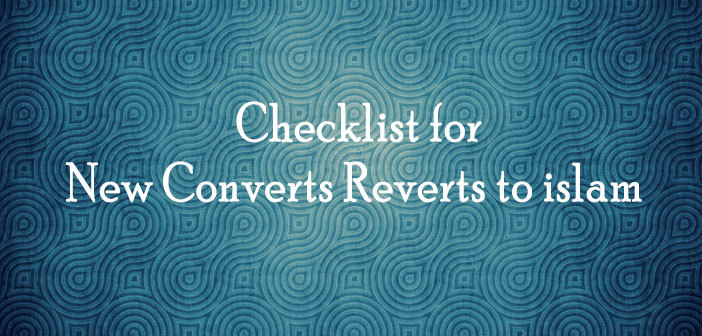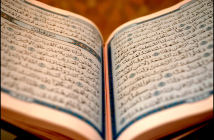Converts/Reverts, or potential converts to Islam, please take note. Your future is at stake.
By
(Imam) Syed B. Soharwardy
Introduction
Due to the division among Muslims, it can be very confusing for many western people who want to convert/revert to Islam to know which version of Islam is the true Islam. Moreover, the recent escalation in the radicalization of Muslim converts and their exploitation by extremist groups is alarming and dangerous. Therefore, it is important to understand what Islam is and what is NOT Islam. In this article I am not going to discuss why someone would convert to Islam? I am assuming that (hypothetical) person has acquired some basic understanding of Islam and now is willing to become a Muslim.
When a person wants to convert / revert to Islam he / she must consider the following two most important criteria for deciding which Imam or group can guide this individual towards the true Islam.
- What interpretation of Qur’an and Sunnah has been followed by the greatest majority of Muslim scholars throughout the fourteen centuries of Islam? Does this Imam or group follow the same interpretation, or do they follow something different?
- What traditions of Islam have been followed by the overwhelming majority of Muslim throughout the fourteen centuries of Islam? Does this Imam or group follow the same traditions or do they advocate something completely different?
Background and Confusion
Starting from the first century of Islam, Muslims were divided into two denominations. A Small minority separated themselves from the majority and between 10% to 15% of these Muslims identified themselves as Shia while the rest of the Muslims identified themselves as Sunni (Ahle Sunnah wal Jama’h). I am not going to discuss the reasons of this division. Moreover, the Shia Sunni divide has not been known to create a major confusion for potential converts. The major source of confusion and/or misguidance for many converts is the existence of several groups (sects) within Sunni denomination. Therefore, I am going to discuss the historical Sunni understanding and interpretation of Islam. Over the years several sects/groups have emerged from the Sunni denomination – each one identifying itself as “Sunni Muslim” – but mostly embracing interpretations of the Qur’an and Sunnah that the majority of Sunni scholars have never accepted.
The First Deviants
During the first century of Islam a group emerged from the region now identified as Syria and Iraq. The followers of this group claimed they understood Qur’an and Sunnah better than the thousands of Companions of Prophet Muhammad (peace be upon him). This group refused to accept the authority of the government. They refused to follow the laws of the country and created rebellion against the third Caliph of Islam Hazrat Osman Ibn Affan (May Allah be pleased with him). They murdered him. When the fourth Caliph Hazrat Imam Ali Ibn Abi Talib (Allah be pleased with him), who was also the cousin and the son-in-law of Prophet Muhammad (peace be upon him), took over the power they refused to accept him as the ruler. They also murdered him. This group had a very strange interpretation of Qur’an. Their interpretation was completely new and far from the understanding of thousands of Muslims who had accepted Islam right in front of Prophet Muhammad (peace be upon him). This latter group, known as “the companions” (SAHABAH) had learnt Qur’an and Islam directly from the Prophet Muhammad (peace be upon him), but the followers of the breakaway group refused to accept the interpretation of the Sahabah and murdered thousands of the companions. This deviant group were extremist, very violent people. Although they were a small minority, their terrorism was huge and caused irreparable damage to Muslims. In history they are recognized as KHAWARIJ (outsiders of Islam). The vast majority of Muslims have NEVER agreed with their interpretation of Qur’an and Sunnah. With the passing of time the KHAWARIJ group diminished and slowly ended.
The Division
Although the Khawarij were isolated, and finally ended, Muslims have remained divided into Sunni and Shia schools of thoughts. Over the several centuries, the Shia denomination was further divided into several groups: Ismaili, Ithna Ashari, Bohra, Alavi, etc. The followers of these Shia sects have identified themselves with their sects, for example, Ismaili Shia Muslims, Ithani Ashri Shia Muslim, etc. Similarly, Sunnis became divided into four groups; Hanafi, Shafiee, Maliki and Hanbali, but the followers of these four Sunni groups never identified themselves as sects. They still considered themselves Sunnis (Ahle Sunnah Wal Jama’h). The source of this division among Sunnis was the difference in the interpretation of the jurisprudence of Islam called the Sharia Law. The followers of these four Sunni groups (Mazahib) remained united on traditions and beliefs (AQEEDAH) based upon the Imam Matarudi and Imam Ash’ari’s understanding / interpretation of Islam. Even with all these divisions, the Sunni scholars have never called each other “wrong.” They tended to be extremely tolerant and accepting of their differences. They still prayed together and lived together in peace and harmony with each other.
The Dangerous Division
Up to the 1700s, Sunni Muslims, worldwide, had much the same beliefs and traditions but were divided on FIQH (Sharia law). During the 1700s and 1800s, when European powers invaded Asian and African countries to colonize them, the Khawrji beliefs were revived once again in Muslim countries in order to destroy the Ottoman Empire. Arab Nationalism and the violent ideology of Khawrjis were useful tools in aiding the European powers to divide Muslims and to pit them against each other. This strategy worked very well, and European powers were successful in colonizing almost all Muslim countries.
The formation of Saudi Arabia took place during the same time. Ottoman Turkish rulers were the custodians of the two holy sites of Islam, but an alliance between a radical clergyman and a tribal chief of Najd area, with the backing from Britain, defeated the Ottomans. Thus, Saudi Arabia was formed. The man of the clergy of Najd was Muhammad Bin Abdul Wahab. He revived the Khawrji beliefs and justified the killings of thousands of Muslims just as the Khawarij had done when they killed thousands of Sahabahand the family members of Prophet Muhammad (peace be upon him), and “rationalized” their acts by using their own interpretation of Qur’an and Sunnah. Muhammad Bin Abdul Wahab demolished hundreds of Islamic heritage sites Muslims had lovingly preserved over the centuries as a part of Islam’s history. He demolished thousands of tombs of various Sahabah and family members of Prophet Muhammad (peace be upon him), which Muslims had built and protected throughout the history of Islam. He destroyed hundreds of historic archeological sites of Islam that had been preserved right from the period of Prophet Muhammad (peace be upon him), by all Muslim governments and by all Muslims, until those sites were destroyed just less than a century ago. In fact, Muhammad Bin Abdul Wahab even wanted to demolish the ROWDHA of Prophet Muhammad (peace be upon him) where he was buried inside Masjid Al Nabawi in Madinah city.
At that time the entire community of Muslim scholars Shia and Sunni condemned Muhammad Bin Abdul Wahab and his followers. No one accepted his interpretation of Qur’an and Sunnah.
The Revival of Khawarijism
Today Muslims are struggling once again with similar challenges; however, the current challenges are more serious and more impactful upon Muslims and on their faith, Islam. Today, the majority of Muslims are struggling with economic challenges. Nearly all Muslim countries are classed as under-developed – facing poverty, illiteracy and corrupt dictators. Also, Saudi Arabia has become a strong economy in the world. Saudi Arabia is a member of G20 countries, and one the closest allies of United States, Canada and other western countries. Saudi Arabia also gives aid to a number of Muslim countries. Millions of Muslims and non-Muslims work in Saudi Arabia. The country has helped in rebuilding several countries after wars or natural disasters. It has also helped build thousands of mosques in the western world and in the Muslim world.
However, the Saudi help does not come without attachments. The economic and financial help from Saudi Arabia always has a price tag and that price tag is the importation and adoption of Muhammad Bin Abdul Wahab’s interpretation of Islam, known as WAHABISM OR SALAFISM. Wherever a mosque has been built with Saudi money, the Imam has had to be either imported from Saudi Arabia, educated in Saudi Arabia, OR a follower of the Wahabi/Salafi version of Islam.
Some Important Facts
Before the civil war in Bosnia Herzegovina, there were hardly any mosques that could be considered Wahabi/Salafi Mosques. After the civil war ended, Saudi Arabia helped in rebuilding mosques and universities in Bosnia Herzegovina. Before the Afghan Jihad against the former Soviet Union, less than 20% of the mosques in Pakistan were Wahabi/Salafi/deobandi mosques. Saudi Arabia has provided lots of money and Mujahideen through the government of General Ziaul Haq in Pakistan. Lots of money and Saudi clergy came to Pakistan. Today more than 60% of the mosques in Pakistan are either Wahabi/Salafi or Deobandi mosques. (Deobandi is another version of Wahabi/Salafi sect in South Asia). In other parts of the world such as central Asia, Indonesia, Malaysia, North Africa, Middle East the Wahabi / Salafi influence is on the rise exponentially. An overwhelming majority of Mosques in the United States and Canada have also received funding from Saudi Arabia. Therefore, the Wahabi/Salafi influence in North American mosques is huge. Millions of Sunni Muslims who migrated from the various Muslim countries to North America were the followers of non-Wahabi Sunni schools of thoughts in their country of birth, but when they settled in the US or Canada they converted to theWahabi/Salafi sect. The reasons are obvious, the majority of mosques in North America are controlled and run and managed by Wahabi / Salafi Imams and their followers. No other Sunni group has the kind of resources and the funding that Wahabis have.
Moreover, since the Islam’s two holy sites, Makkah and Madinah, are in Saudi Arabia, millions of Muslims visit Saudi Arabia for pilgrimage (Hajj & Umrah). The majority of Muslims do not know the history of Islam and the history of the Wahabi beliefs. The perception of most Muslims is that the clergy, which controls the two holy sites, must be correct. I wish they had been born 150 years ago. They would have seen a very different view of Islam and Islamic heritage sites in Makkah and Madinah when Ottomans were ruling these cities. Millions of Muslims work in Saudi Arabia, and they certainly learn Islam from the Saudi clergy. They believe they are learning from the source. They do not know that the source has been contaminated.
Comparison
Let us compare some of the key differences between the beliefs of Sunni Muslims vs the Wahabi / Salafi beliefs.
| Sunni Muslim Beliefs(practiced by ALL Sunni Muslims for 1400 years of Islam) | Wahabi / Salafi Beliefs(started after the Wahabi revolution in Saudi Arabia less than 200 years ago) | |
| Sunni Muslims have existed since the start of Islam more than 1400 years ago. | Wahabis / Salafis (Khawarij) emerged for a short period of time during the Khilafah of HazratOsman and Imam Ali (May Allah be pleased with them. At that time they used to be called KHAWARIJ. They re-emerged in mid 1700s in the Arabian peninsula. | |
| All Sunni Muslim must follow one of the four Jurist Imams (Fiqh); Hanafi, Shafi’ee, Maliki &Hanbali | Wahabis / Salafis do not follow any of the four Imams of Fiqh. | |
| All Sunni Muslims believe in the intercession of Prophet Muhammad (peace be upon him) on the judgement day. | Wahabis / Salafis do not believe in the intercession (Shifa’h) of Prophet Muhammad (peace be upon him) | |
| All Sunni Muslims believe in Tawassul(mediation) to Allah | Wahabis / Salafis do not believe in Tawassul(Mediation) to Allah. | |
| All Sunni Muslims believe in celebrating the birthday of Prophet Muhammad (peace be upon him) called Eid Milad un Nabi. The formal celebration of Prophet Muhammad’s (peace be upon him) birthday started 250 -300 years after he passed away. Since then All Muslims, Shia and Sunni, both celebrate Eid Milad un Nabi (peace be upon him). No single scholar of Islam ever objected to this celebration. All Muslim countries celebrate this day as a national holiday except Saudi Arabia and Qatar. | Wahabis / Salafis do not believe in celebrating EidMilad un Nabi (peace be upon him). They consider this a Bid’a (innovation in Islam). If anyone ever tries to celebrate Eid Milad un Nabi (peace be upon him) in Saudi Arabia publicly the person will prosecuted, jailed and deported. It’s a crime in Saudi Arabia. That is why Wahabis /Salafis consider a person an infidel if he/she celebrates Prophet Muhammad’s birthday (Peace be upon him). | |
| All Sunni Muslims praise and honour Prophet Muhammad (peace be upon him) by singing poems and rhymes (Naat & Nasheed) | Praising and honouring Prophet Muhammad (peace be upon him) pains Wahabis / Salafis. | |
| All Sunni Muslims respect and accept differences of opinions. For Sunni Muslims the followers of all four Fiqh Imams; Hanafi, Maliki, Shafi’ee and Hanbali were correct and must be respected although they differ from each other on many rulings of Islamic law. | Wahabi / Salafi cannot tolerate any disagreement or difference of opinions. They believe they are the only right Muslims and all other Muslims are pagans, non-believers or hell bound. | |
| All Sunni Muslims love Aulia Allah (Sufis of Islam) and visit their graves. | Wahabis / Salafis hate Sufis. Visiting graves ofAulia Allah is shirk (paganism) for them. | |
| It is every Muslim’s life time desire to visit the ROWDAH (grave) of Prophet Muhammad (peace be upon him) in Masjid Al Nabawi in Madinah city. | Wahabis / Salafis consider this as shirk. They say one can go to Masjid Al Nabwi to pray there and should not have the intention to visit the ROWDAH of Prophet Muhammad (peace be upon him) | |
| All Sunni Muslims believe in the sanctity of life, whether Muslim or non-Muslim. Killing innocent men, women and children (Muslim or non-Muslim) is a major sin and crime in Islam. | Wahabis / Salafi believe in the forceful conversion of non-Muslims. Anyone who refuses their authority and judgement is subject to death, Muslim or non-Muslim. |
So what must New Converts do?
The problem is confusing and serious. When a person goes to a mosque or meets an Imam to convert to Islam, the person often does not know the beliefs and the sect of the Imam. A Wahabi / Salafi NEVER calls himself/herself a WAHABI / SALAFI. They call themselves “true Muslims.” KHAWARIJ never considered themselves as outsiders of Islam, either. In fact, they kicked out every Muslim from the Islamic fold and took over the ownership of Islam. Wahabis / Salafis call themselves true Muslims, and consider all other Muslims are either pagans or damned. So, how can a person who wants to embrace Islam ensure that he/she is really embracing Islam, and not WAHABISM / SALAFISM disguised as Islam?
The answer is very simple. Check the Imam or the person who is going to teach you Islam as to whether he/she believes according to the Sunni beliefs, or the beliefs of Wahabi/Salafi sect. You should not be misguided by the Wahabis / Salafis and later get recruited to fight for that most dangerous terrorist, and the WAHABI/SALAFI organization called ISIS/ISIL.
The checklist
Please ask the following questions to the Imam or the person helping you to understand Islam.
- Do you agree Islam protects the sanctity of life of all human beings including Christians, Jews and others?
- Do you believe Muslims can live in peace and harmony with Christians and Jews?
- Do you stand up to protect the rights of non-Muslim minorities in Muslim countries?
- Do you agree Muslims who were recruited by ISIL/ISIS were misled and radicalized?
- Do you write and speak against the ideology of ISIS/ISIL, Boko Haram, Al Qaeda, Taliban, etc.? Do you agree their ideology, beliefs and actions are criminal and completely un-Islamic?
- Do you agree in Islam no individual or a group can declare armed Jihad against anyone?
- Do you agree Muslims must be loyal law-abiding citizens of the countries they live in?
- Do you believe in Islam men and women have equal rights?
- Do you believe honour killings are un-Islamic and major crime in Islam?
- Do you consider forced and underage marriages to be un-Islamic?
- Do you believe non-Muslims in Muslim countries should be forced to become Muslims?
- Do you believe Muslims of other sects will go to hell unless they follow your beliefs?
- Do you call other Muslims who may disagree with your beliefs and traditions “Kafir (non-believer)”, “Mushrik (pagans)” OR Bid’atee (innovators)?
The answers for questions 1 -10 = YES. Answers for questions 11-13 = NO.
Conclusion
I also request that the media, law enforcement agencies, government officials NOT refer to ISIS/ISIL, Al Qaeda, Taliban, Al Shabab, Boko Haram, Al Nusrah, Khorasan, etc. as “Sunni Muslims.” All these terrorist organizations, their members and sympathizers, are the followers of Wahabism / Salafism. They must be identified with their correct affiliation. They are not Sunni Muslims.
If any brother or sister who would like to embrace Islam and need help you can contact me at 1-416-994-5467 OR email: contact@islamicsupremecouncil.com , www.iscc.ca
Who is Imam Syed Soharwardy?
http://www.islamicsupremecouncil.com/soharwardy.htm
Acknowledgement: I am grateful to Linda Zachri for proof reading this article.






